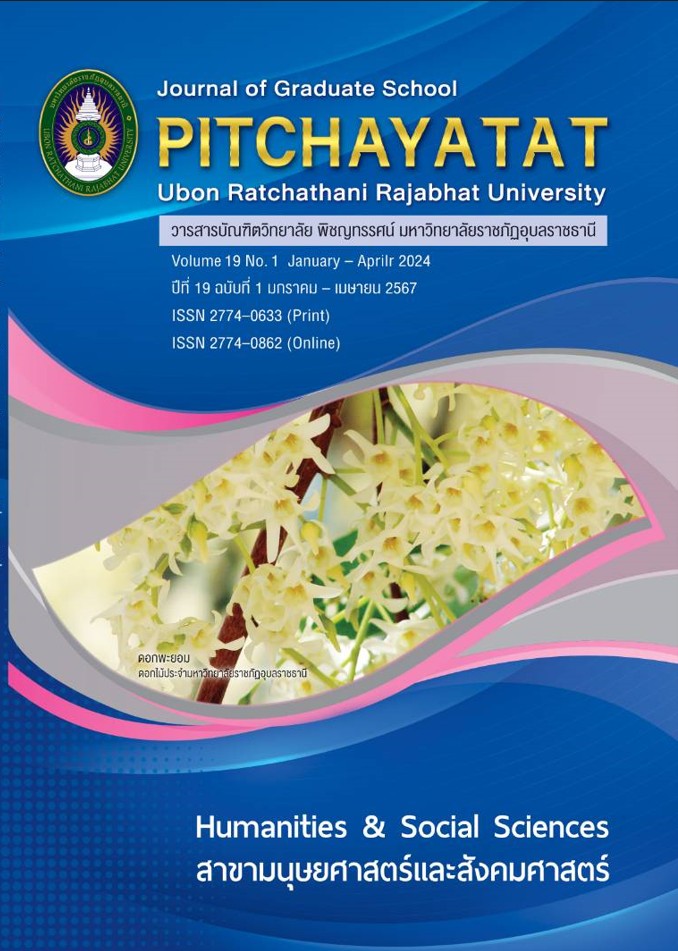ผลการจัดการเรียนรู้โดยใช้วิจัยเป็นฐานร่วมกับการประยุกต์ใช้ SOLO Taxonomy เพื่อพัฒนาผลสัมฤทธิ์ทางการเรียนและทักษะนวัตกร ของนักเรียนชั้นประถมศึกษาปีที่ 2
คำสำคัญ:
ทักษะนวัตกร, วิจัยเป็นฐาน, SOLO Taxonomyบทคัดย่อ
การวิจัยนี้มีวัตถุประสงค์เพื่อ 1) เปรียบเทียบผลสัมฤทธิ์ทางการเรียนวิชาวิทยาศาสตร์ของนักเรียนชั้นประถมศึกษาปีที่ 2 ก่อนและหลังการจัดการเรียนรู้โดยใช้วิจัยเป็นฐานร่วมกับการประยุกต์ใช้ SOLO Taxonomy 2) เพื่อประเมินทักษะนวัตกรของนักเรียนชั้นประถมศึกษาปีที่ 2 หลังการจัดการเรียนรู้โดยใช้วิจัยเป็นฐานร่วมกับการประยุกต์ใช้ SOLO Taxonomy ตัวอย่างคือนักเรียนชั้นประถมศึกษาปีที่ 2 โรงเรียนวัดลาดหลุมแก้ว จำนวน 17 คน ซึ่งได้มาจากการเลือกตัวอย่างแบบเจาะจง เครื่องมือที่ใช้ ได้แก่ 1) แผนการจัดการเรียนรู้วิชาวิทยาศาสตร์ เรื่องวัตถุและสมบัติของวัสดุ มีค่าเฉลี่ย ตั้งแต่ 4.34-5.00 ส่วนเบี่ยงเบนมาตรฐาน ตั้งแต่ .00 - .58 2) แบบทดสอบวัดผลสัมฤทธิ์ทางการเรียน เรื่องวัตถุและสมบัติของวัสดุ มีค่าอำนาจจำแนกตั้งแต่ 0.32-0.59 ค่าความเชื่อมั่นเท่ากับ 0.78 ค่าความยากง่ายตั้งแต่ 0.50-0.90 3) แบบประเมินทักษะนวัตกร มีค่าดัชนีความสอดคล้อง ตั้งแต่ .67-1.00 สถิติที่ใช้ ได้แก่ ค่าเฉลี่ย ค่าส่วนเบี่ยงเบนมาตรฐาน ทดสอบสมมติฐานด้วย สถิตินอนพาราเมตริก ใช้วิธีทดสอบแบบ Wilcoxon Signed Ranks Test และ One-sample t-test
ผลการวิจัยพบว่า
- นักเรียนชั้นประถมศึกษาปีที่ 2 ที่ได้รับการจัดการเรียนรู้โดยใช้วิจัยเป็นฐานร่วมกับการประยุกต์ใช้ SOLO Taxonomy มีผลสัมฤทธิ์ทางการเรียนหลังเรียนสูงกว่าก่อนเรียนอย่างมีนัยสำคัญทางสถิติที่ระดับ .05
- นักเรียนมีทักษะนวัตกรอยู่ในระดับมาก มีค่าเฉลี่ย เท่ากับ 12.76
เอกสารอ้างอิง
เกริก ท่วมกลาง. การพัฒนาสื่อ/นวัตกรรมทางการศึกษาเพื่อเลื่อนวิทยฐานะ. กรุงเทพฯ: สถาพรบุ๊คส์, 2555.
จิราภร คุ้มมณี. การเรียนรู้แบบสะตีมเกมมิฟิเคชันเพื่อเสริมสร้างทักษะด้านนวัตกรรมสร้างสรรค์ของนวัตกรอาชีวศึกษา. วารสารวิชาการมหาวิทยาลัยการจัดการและเทคโนโลยีอีสเทิร์น. 15, 2 (กรกฎาคม-ธันวาคม 2561): 169-177.
ชัยยงค์ พรหมวงศ์. การทดลองประสิทธิภาพสื่อหรือชุดการสอน. วารสารศิลปากรศึกษาศาสตร์วิจัย. 5, 1 (มกราคม-มิถุนายน 2555): 8-20.
ทิศนา แขมมณี. ศาสตร์การสอน. พิมพ์ครั้งที่ 15. กรุงเทพฯ: โรงพิมพ์แห่งจุฬาลงกรณ์มหาวิทยาลัย, 2555.
ทิศนา แขมมณี. 14 วิธีสอนสำหรับครูมืออาชีพ. กรุงเทพฯ: โรงพิมพ์แห่งจุฬาลงกรณ์มหาวิทยาลัย, 2546.
ไพฑูรย์ สินลารัตน์. ครูในศตวรรษที่ 21. กรุงเทพฯ: สำนักงานส่งเสริมสังคมแห่งการเรียนรู้และคุณภาพเยาวชน (สสค.), 2557.
พระราชบัญญัติการศึกษาแห่งชาติ. ราชกิจจานุเบกษา, เล่ม 116 ตอนที่ 74ก. หน้า.1-28. 19 สิงหาคม 2553.
มานิต กีรตินิตยา. การพัฒนาทักษะกระบวนการวิจัยผลสัมฤทธิ์ทางการเรียนและเจตคติต่อการเรียนวิทยาศาสตร์เรื่องวัสดุและสมบัติของวัสดุสาระการเรียนรู้วิทยาศาสตร์ชั้นประถมศึกษาปีที่ 5 โดยใช้การวิจัยเป็นฐาน. วิทยานิพนธ์การศึกษามหาบัณฑิต มหาวิทยาลัยมหาสารคาม, 2552.
ลัดดา ภู่เกียรติ. การสอนแบบโครงงานและการสอนแบบใช้วิจัยเป็นฐาน: งานที่ครูประถมทำได้. กรุงเทพฯ: สาฮะแอนด์ซันพริ้นติ้ง, 2552.
วิชัย วงษ์ใหญ่ และมารุต พัฒผล. กระบวนทัศน์ใหม่การ Mentor and Coaching ในสังคมสื่อสารสนเทศเพื่อเสริมสร้างศักยภาพนักศึกษาฝึกประสบการณ์วิชาชีพครู. กรุงเทพฯ: มหาวิทยาลัยศรีนครินทรวิโรฒ, 2557.
ศึกษาธิการ, กระทรวง. หลักสูตรแกนกลางการศึกษาขั้นพื้นฐาน พุทธศักราช 2551. กรุงเทพฯ: กระทรวงศึกษาธิการ, 2551.
Dyer, J. H., H. B Gregersen and C. M.Chistensen. The innovator's DNA: Mastering the five skills of disruptive Innovators. (online) 2011. (cited 18 August 2021). Available from: https://www.iimidr.ac.in/wp-content/uploads/Vol.-4-Issue-3-Full1.pdf
Fullan, M. The six secrets of change. San Francisco: Jossey-Bass, 2008.
Kieu. 8 skills that make a successful innovator. (online) 2017. (cited 22 April 2021). Available from: https://sociable.co/business/innovation- HYPERLINK https://sociable.co/business/innovation-8-skills/?fbclid=IwAR1uWVizjg-64YK3-bV1kBkUoF0uz5Rq9Uj_NMV-H89os8N-_i6g72JlcH4
Sulistiyono, B. et al. Students’ creative-innovative thinking skill in solving rainbow antimagic coloring under research based learning model. (online) 2020. (cited 23 August 2022). Available from: https://www.researchgate.net/publication/350329424 The analysis of students' creativeinnovative thinking skills in solving total dominator coloring under the implementation of research-based learning model
Wagner, T. The making of young people who will change the world. (online) 2018. (cited 5 May 2021). Available from: https://www.tonywagner.com/news/creating-innovators
ดาวน์โหลด
เผยแพร่แล้ว
รูปแบบการอ้างอิง
ฉบับ
ประเภทบทความ
สัญญาอนุญาต
ลิขสิทธิ์ (c) 2024 วารสารบัณฑิตวิทยาลัย พิชญทรรศน์ มหาวิทยาลัยราชภัฏอุบลราชธานี

อนุญาตภายใต้เงื่อนไข Creative Commons Attribution-NonCommercial-NoDerivatives 4.0 International License.
บทความทุกเรื่องได้รับการตรวจความถูกต้องทางวิชาการโดยผู้ทรงคุณวุฒิภายนอกอย่างน้อย 3 คน ความคิดเห็นในวารสารพิชญทรรศน์เป็นความคิดเห็นของผู้นิพนธ์มิใช่ความคิดเห็นของผู้จัดทำ จึงมิใช่ความรับผิดชอบของวารสารพิชญทรรศน์ และบทความในวารสารพิชญทรรศน์สงวนสิทธิ์ตามกฎหมายไทย การจะนำไปเผยแพร่ต้องได้รับอนุญาตเป็นลายลักษณ์อักษรจากกองบรรณาธิการ





